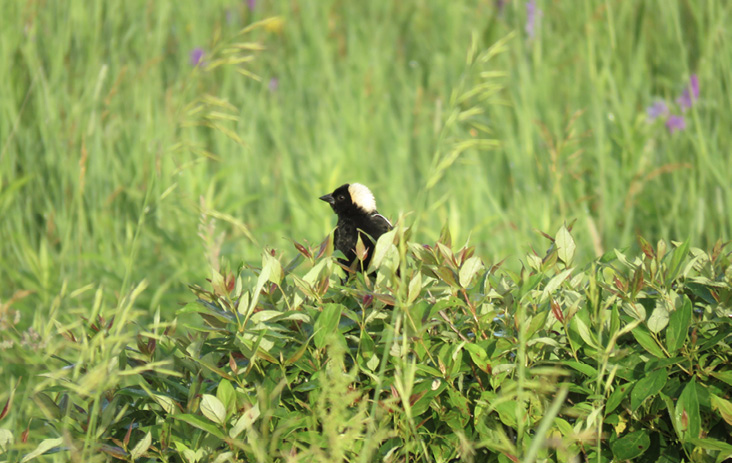Hyla Howe

A male Bobolink perches in vegetation. Photograph by Allan Strong.
When you hear the term “grassland birds,” what is the first thing that comes to your mind? For me, it is a sense of peace as I close my eyes and am transported to the edge of a misty hayfield at dawn. Birdsong rings out so profusely that it takes all my focus to keep track of the individual voices that I am hearing. I scribble banding codes into my notebook furiously as my fingers get cold. In these moments, it is hard to not feel a sense of abundance, an overflowing gratitude for these quiet spaces and the birds that fill them, and a connection to the landscapes that house and feed all of us. If you are a farmer, you may have a different feeling. It may be one of deep connection with the breeding birds that share your land, or perhaps frustration at the birders who ask you to sacrifice the quality of your hay harvest. Birders might feel excited by the thought of finding their first Eastern Meadowlark of the season or searching for an even more elusive Grasshopper Sparrow or Sedge Wren. They may also feel a general unease as they are reminded of the precipitous population declines among grassland species in recent decades.
Grassland birds are an enigmatic guild, and efforts to conserve them in the northeastern United States are complex but promising. As the name suggests, grassland species thrive in open, grass-dominated habitats like the prairies that were once expansive in the Great Plains and along the Atlantic coast. Those ecosystems relied on periodic disturbances, or on specific soil conditions, to keep forests at bay. Over the last several hundred years our landscapes have undergone immense shifts, transitioning from complex mosaics of grassy openings and forests in varying stages of succession to monocultures of crops, urban and suburban sprawl, even-aged forest stands, and heavily managed hayfields and pastures.
To view the rest of the article you'll need to
subscribe. Bird Observer publishes original articles on birding locations, on avian populations and natural history, on regional rarities, field notes, field records, photographs, and art work.